Neum
Neum (Croatian pronunciation: [něum][1]) is a town and municipality in Bosnia and Herzegovina, located in Herzegovina-Neretva Canton of the Federation of Bosnia and Herzegovina entity. It is the only town to be situated along Bosnia and Herzegovina's 20 km (12 mi) of coastline,[2] making it the country's only access to the Adriatic Sea. As of 2013, Neum municipality has a population of 4,960 inhabitants, while the town of Neum has a population of 3,013 inhabitants.
Neum Неум | |
|---|---|
Town and municipality | |
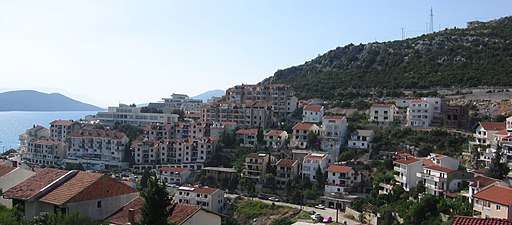 Neum | |
 Flag 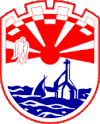 Seal | |
 Location of Neum municipality within Bosnia and Herzegovina | |
| Coordinates: 42°55′30″N 17°37′00″E | |
| Country | Bosnia and Herzegovina |
| Entity | Federation of Bosnia and Herzegovina |
| Canton | Herzegovina-Neretva |
| Government | |
| • Municipality president | Živko Matuško (HDZ BiH) |
| Area | |
| • Total | 225 km2 (87 sq mi) |
| Population (2013 census) | |
| • Total | 4,960 |
| • Density | 22/km2 (60/sq mi) |
| Time zone | UTC+1 (CET) |
| • Summer (DST) | UTC+2 (CEST) |
| Area code(s) | +387 36 |
| Website | www |
Features
Neum is a small town located in mild Mediterranean climate that has steep hills, stone-sandy beaches, and several large tourist hotels. The inland area behind Neum has a rich archeological history and untouched wilderness with centuries-old olive groves in the hinterland.
Neum has about 5,000 beds for tourists, 1,810 in hotels with the remaining capacity in motels, villas, and private accommodation. Tourism in Neum is active only in the coastal region. Prices tend to be lower than in neighbouring Croatia, making it popular with shoppers. Tourism, and the commerce it brings, is the leading contributor to the economy of the area.
Geography
Overview
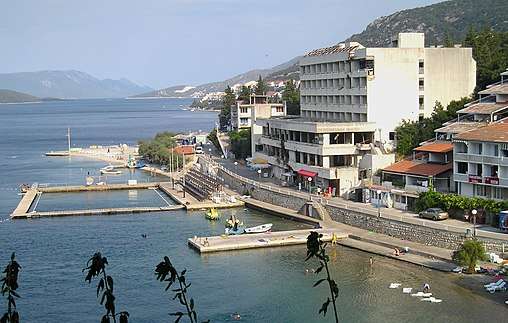
Neum is 60 km (37 mi) from Dubrovnik (80 km (50 mi) from Dubrovnik Airport), 70 km (43 mi) from Mostar and Međugorje and 30 km (19 mi) from Ploče and Metković, both of which have railway stations.
The Bosnia and Herzegovina coastal strip of Neum cuts off the southernmost Croatian exclave from the rest of Croatia. This is a result of the Treaty of Karlowitz of 1699. With its admission to the European Union, Croatia had to apply EU regulations at its border crossings, including the passage through the Neum section .
The construction of the Pelješac Bridge, which would bypass Neum entirely, has significance for Croatia's integrity and also for its future Schengen Area membership and the EU as a whole. It would significantly improve traffic flow and the traffic connection of Dubrovnik to the rest of mainland Croatia, avoiding crossing the external borders of the EU at Neum, negotiating long, costly queues and strict customs checks twice within the space of 20 km.
Encouraged by the recent developments in Croatia - Slovenia maritime border dispute (June 2017), the ruling Bosniak Party of Democratic Action (SDA) and other Bosnian political parties have decided to obstruct the €420 million worth project previously approved by the EU. The EU Commission has already allocated €357 million of Cohesion Policy funds to build the bridge. It should be completed by 2022.
Neum is planned to be a freight port. There are plans to build a real seaport, rail and a motorway and thus the Croatian bridge must have a high clearance according to the view of Bosnia and Herzegovina. Today the main freight port for Bosnia and Herzegovina is Ploče (in Croatia) further north, which has a railway to Bosnia and Herzegovina.
Subdivision
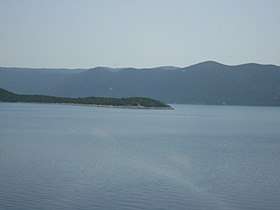
The municipality includes the town of Neum (municipal seat) and several villages:
Babin Do, Borut, Brestica, Broćanac, Brštanica, Cerovica, Cerovo, Crnoglav, Dobri Do, Dobrovo, Donji Drijen, Donji Zelenikovac, Dubravica, Duži, Glumina, Gornje Hrasno, Gradac, Hotanj Hutovski, Hutovo, Kiševo, Moševići, Prapratnica, Previš, Rabrani, Vinine and Žukovica.
Border crossings
Neum has two border crossing checkpoints with Croatia on the European route E65 or Adriatic Highway which connects the two parts of Croatia's Dalmatian coast. Neum 1 is located to the northwest of the city, with the Klek border checkpoint on the Croatian side. Neum 2 is located to the southeast, with the Croatian border checkpoint at Zaton Doli.
History
The Neum corridor dates back to the Treaty of Karlovci of 1699, whereby the Republic of Ragusa was separated from the Dalmatian possessions of its rival Venice by two buffer zones ceded by Ragusa to the Ottoman empire to prevent the possibility of Venice invading via land[3][4]: north of its territory is Neum and the bay of Klek, and south of its territory is Sutorina with the port of Herceg-Novi on the Bay of Kotor, now part of Montenegro since 1947.[5]
The Karlovci borders were reaffirmed in 1718 by the Treaty of Požarevac, but then the Ottomans, tired of negotiating in vain with Venice for a widening of their maritime access, simply usurped the territory of Gornji Klek and most of the Klek peninsula from the Republic of Ragusa, which it had bought from King Stjepan of Bosnia at the end of the 14th century. After the fall of the Venetian Republic in 1797 and the Vienna Congress in 1815, the Austrian Empire, which had annexed both the Dalmatian possessions of Venice and the territory of Dubrovnik, tried to buy back the Neum and Sutorina enclaves from the Ottomans, but in vain. Instead, it stationed a warship to block access to the port of Neum until the Treaty of Berlin, which gave Vienna the whole of Bosnia-Herzegovina in 1878. Neum had been under Ottoman control for 179 years.
In 1918, as a consequence of Vienna's defeat, Neum joined the Kingdom of Serbs, Croats and Slovenes which would start being called "Yugoslavia" in 1929. Under Karađorđević, the Yugoslav Government ignored the borders inherited from history twice: in 1929, when the Neum Region was included in the Littoral Banovina, and in 1939 when, following the Cvetković–Maček Agreement, it was included in the Banovina of Croatia. Tito's federal Yugoslavia was founded on the principle, declared at the 1943 AVNOJ in Jajce and comparatively well-respected by the Đilas commission in 1945, of establishing the federated Republics in their borders of 1878 which is why the Neum enclave is now part of independent Bosnia-Herzegovina, including most of the Klek peninsula (Ponta Kleka, Rep Kleka), the two islets Veliki and Mali Školj and the rock of Lopata in the Bay of Klek.[6]
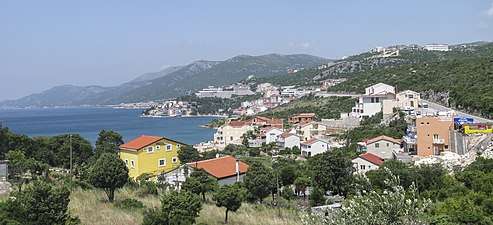 Panorama view of town
Panorama view of town Waterpolo court in Neum
Waterpolo court in Neum Residential Neum
Residential Neum- Aerial view of Neum
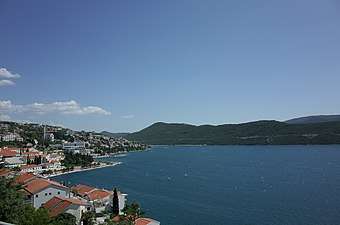 Neum
Neum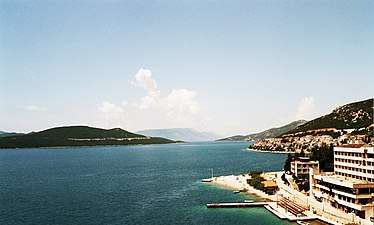 Neum coast
Neum coast- Zenička beach in Neum
 Neum Lighthouse
Neum Lighthouse
Climate
The climate of the area is Mediterranean, characterized by mild winters and dry summers, with three times more rain in the rainier than in the drier months, during which the mean precipitation do not exceed 40 mm (1.57 in). The mean yearly precipitation observed is of 1316 mm (51.8). The dominant winds come from the north, north-east and north-west. The average sea temperature (as observed in Neum) ranges from 13 °C (55 °F) in January to 28 °C (82 °F) in July and August.
Vegetation is the evergreen Mediterranean type, and subtropical flora (palm trees, agaves, cacti) grow in Neum and its surroundings.
| Month | Jan | Feb | Mar | Apr | May | Jun | Jul | Aug | Sept | Oct | Nov | Dec | Year |
|---|---|---|---|---|---|---|---|---|---|---|---|---|---|
| Average maximum temperatures (°C) | 9,7 | 11,3 | 14,3 | 17,5 | 22,5 | 26,2 | 29,7 | 29,4 | 25,9 | 20,6 | 14,8 | 11,2 | |
| Average temperatures (°C) | 6,6 | 7,9 | 10,2 | 13,0 | 17,6 | 21,2 | 24,4 | 24,2 | 20,9 | 16,3 | 11,4 | 8,2 |
15,2 |
| Average minimum temperatures (°C) | 3,6 | 4,5 | 6,1 | 8,6 | 12,7 | 16,3 | 19,2 | 19,0 | 16,0 | 12,1 | 8,0 | 5,2 | |
| Average precipitation (mm) | 135 | 123 | 106 | 100 | 75 | 59 | 38 | 52 | 88 | 127 | 174 | 172 |
1249 |
Demographics
Population
| Population of settlements – Neum municipality | |||||
|---|---|---|---|---|---|
| Settlement | 1971. | 1981. | 1991. | 2013. | |
| Total | 4,781 | 4,030 | 4,325 | 4,960 | |
| 1 | Gradac | 345 | 234 | ||
| 2 | Hutovo | 319 | 201 | ||
| 3 | Neum | 360 | 602 | 1,651 | 3,013 |
Ethnic composition
| Ethnic composition – Neum town | ||||||
|---|---|---|---|---|---|---|
| 2013. | 1991. | 1981. | 1971. | |||
| Total | 3,013 (100,0%) | 1,651 (100,0%) | 602 (100,0%) | 360 (100,0%) | ||
| Croats | 2,938 (97,51%) | 1,338 (81,04%) | 499 (82,89%) | 335 (93,06%) | ||
| Bosniaks | 33 (1,161%) | 89 (5,391%) | 17 (2,824%) | 3 (0,833%) | ||
| Serbs | 21 (0,697%) | 98 (5,936%) | 25 (4,153%) | 10 (2,778%) | ||
| Unaffiliated | 6 (0,199%) | |||||
| Albanians | 3 (0,100%) | 4 (0,664%) | ||||
| Unknown | 3 (0,100%) | |||||
| Others | 3 (0,100%) | 36 (2,180%) | 3 (0,498%) | 5 (1,389%) | ||
| Yugoslavs | 2 (0,066%) | 90 (5,451%) | 47 (7,807%) | 7 (1,944%) | ||
| Montenegrins | 2 (0,066%) | 6 (0,997%) | ||||
| Macedonians | 1 (0,166%) | |||||
| Ethnic composition – Neum municipality | |||||||
|---|---|---|---|---|---|---|---|
| 2013. | 1991. | 1981. | |||||
| Total | 4,960 (100,0%) | 4,325 (100,0%) | 4,030 (100,0%) | ||||
| Croats | 4,543 (97,64%) | 3,792 (87,68%) | 3,575 (88,71%) | ||||
| Bosniaks | 63 (1,397%) | 190 (4,393%) | 157 (3,896%) | ||||
| Serbs | 21 (0,451%) | 207 (4,786%) | 179 (4,442%) | ||||
| Unaffiliated | 7 (0,150%) | ||||||
| Unknown | 7 (0,150%) | ||||||
| Albanians | 3 (0,064%) | 5 (0,124%) | |||||
| Others | 3 (0,064%) | 46 (1,064%) | 17 (0,422%) | ||||
| Yugoslavs | 2 (0,043%) | 90 (2,081%) | 89 (2,208%) | ||||
| Montenegrins | 2 (0,043%) | 7 (0,174%) | |||||
| Macedonians | 1 (0,025%) | ||||||
Culture and sport
Neum celebrates the feast of Our Lady of Good Health as its municipal day. As part of the celebrations, Neum hosts the Music Festival Etnofest Neum. The town also hosts the Neum Animated Film Festival.[7]
The linđo is traditionally danced in the Neum region.[8]
Neum is home to local branches of the cultural organizations Matica hrvatska and HKD Napredak.[9][10]
Popular activities include swimming and sun bathing, beach-going, boating, and various other water-sports. Neum has a water polo club VK Jadran Neum, which is a member of the Croatian Water Polo Federation.
 Folk costumes from Neum
Folk costumes from Neum- Roman Catholic church in Neum
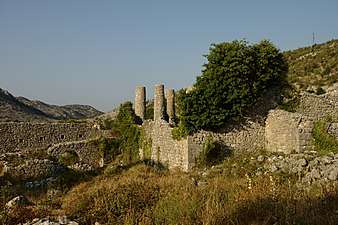 Hutovo fortress ruins
Hutovo fortress ruins- Stećak from Neum
Maritime
The Sutorina dispute was a border dispute between Montenegro and Bosnia and Herzegovina regarding the sovereignty over the territory of Sutorina. In the end government of Bosnia signed the agreement (by Minister of Foreign Affairs Igor Crnadak and/or witnessed by the Croat Member of the Presidency of Bosnia and Herzegovina Dragan Čović) agreeing that Sutorina was part of Montenegro.
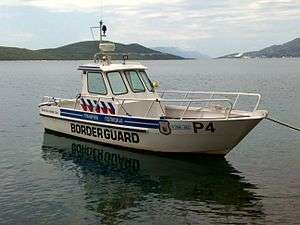 BiH coast guard / border police
BiH coast guard / border police.jpg) US. Frigate USS Nicholas anchored at Neum
US. Frigate USS Nicholas anchored at Neum%2C_one_of_the_three_current_Presidents_of_Bosnia_and_Herzegovina%2C_greets_Mr._Clifford_Bond%2C_U.S._Ambassador_to_Bosnia_and_Herzegovina.jpg) Sulejman Tihić greets U.S. Ambassador to BiH aboard USS Nicholas (2003)
Sulejman Tihić greets U.S. Ambassador to BiH aboard USS Nicholas (2003)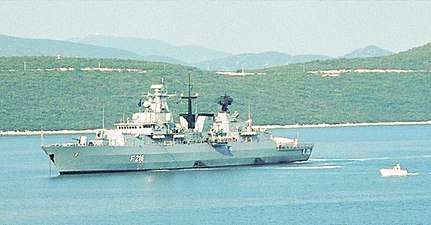 German frigate Schleswig-Holstein anchored at Neum
German frigate Schleswig-Holstein anchored at Neum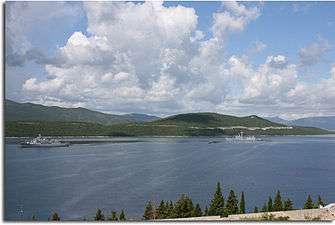 Turkish ships anchored at Neum (2011)
Turkish ships anchored at Neum (2011)
Neum-Klek naval port (WWI)
Consideration was given to a plan to build a new advanced naval base at Neum-Klek by Austro-Hungarian Navy. General Franz Conrad von Hötzendorf considered fortifying Neum with coastal batteries and torpedo craft to supplement seafront defenses (in order to prevent Italian raids, or worse large scale Italian landing). The project never got past the planning stage prior to the outbreak of War in 1914.
.jpg) Huszár-class destroyer of Austro-Hungarian Navy (Neum 1916)
Huszár-class destroyer of Austro-Hungarian Navy (Neum 1916).jpg) Torpedo boat guarding steamers
Torpedo boat guarding steamers.jpg) Transport steamer (SS Linz type ship)
Transport steamer (SS Linz type ship).jpg) Transport steamer; March 1916
Transport steamer; March 1916.jpg) Transport steamer up close
Transport steamer up close
See also
References
- "Nèum". Hrvatski jezični portal (in Croatian). Retrieved 23 February 2020.
- Bosnia-and-Herzegovina Neum britannica.com, britannica.com, 2015-09-09
- Source: "How Bosnia Ended Up With Just 12 Miles of Coastline", "https://www.cntraveler.com/", September 19, 2016
- Source: "Why does Bosnia have a Coast?", "https://www.bigdatabih.com/", December 24, 2018]
- The attribution of Sutorina and Herceg-Novi to the Republic of Montenegro in 1947, a departure from the principle of respecting the borders inherited from history affirmed by Tito in 1943, is rumored to be the consequence of a deal between Đuro Pucar and Blažo Jovanović (Source: "Neum i granični problemi" ("Neum and the border issues"), Poskok.info, December 14th, 2012)
- Source: "Neum i granični problemi", Poskok.info, December 14th, 2012
- Neum Animated Film Festival Archived 2008-09-16 at the Wayback Machine
- "50. Split Summer". Archived from the original on 2008-06-10. Retrieved 2008-09-02.
- Matica hrvatska
- HKD Napredak
External links
| Wikimedia Commons has media related to Neum. |